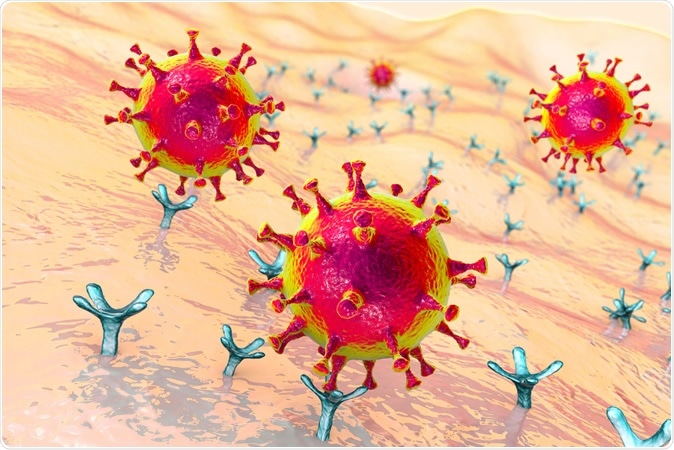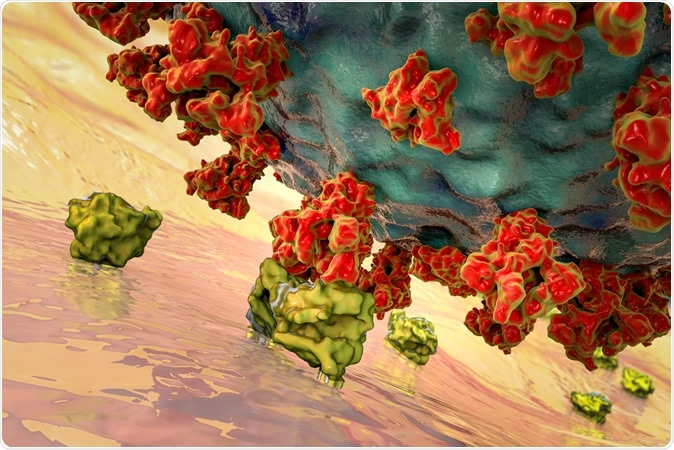The novel coronavirus pandemic has sparked much debate on its origin, with some suggesting it may have been laboratory-grown. Previous studies, however, mentioned that it is zoonotic in nature, which means that the virus jumped from wild animals and found its way to humans.
Now, researchers claim that the virus has uniquely adapted to infect humans, suggesting that the theory of the virus being grown in a laboratory should not be totally excluded.
What are zoonotic diseases?
Zoonotic diseases or zoonoses are infections caused by harmful pathogens like bacteria, viruses, fungi, and parasites that spread from animals to humans. Though many zoonotic diseases are common, some may cause serious illness, including hantaviruses and coronaviruses.

Chengdu/China-Feb.2020: A security guard with face mask outside a local wet market. Image Credit: Amar Shrestha / Shutterstock

 This news article was a review of a preliminary scientific report that had not undergone peer-review at the time of publication. Since its initial publication, the scientific report has now been peer reviewed and accepted for publication in a Scientific Journal. Links to the preliminary and peer-reviewed reports are available in the Sources section at the bottom of this article. View Sources
This news article was a review of a preliminary scientific report that had not undergone peer-review at the time of publication. Since its initial publication, the scientific report has now been peer reviewed and accepted for publication in a Scientific Journal. Links to the preliminary and peer-reviewed reports are available in the Sources section at the bottom of this article. View Sources
Animal pathogens can spread to human populations through direct contact with body fluids of infected animals, going to areas where animals live, being bitten by an insect such as a mosquito or flea, and through the intake of contaminated food.
Today, the world grapples with a new type of coronavirus, the severe acute respiratory syndrome coronavirus 2 (SARS-CoV-2), which causes the coronavirus disease (COVID-19). The exact origin of the virus is yet to be confirmed, but bats as known reservoirs of coronaviruses are top of the ‘most likely’ list.

Bird market in Kowloon, Hong Kong. Image Credit: Christian Mueller / Shutterstock
The novel coronavirus has sickened over 5.4 million people worldwide and caused the death of more than 345,000 people.
Uniquely adapted to infect humans
In a new study available on the preprint server arXiv*, which is yet to be peer-reviewed, the researchers pointed to many reasons why the virus became so well adapted to humans, such as the convergent evolution after exposure to human cells, exposure to human cells very early in the pandemic, and rare mutations that combines two species genes. All these raised new questions on whether the SARS-CoV-2’s origin was natural or could have occurred in a laboratory.
“The devastating impact of the COVID-19 pandemic caused by SARS coronavirus 2 (SARS-CoV-2) has raised important questions on the origins of this virus, the mechanisms of any zoonotic transfer from exotic animals to humans, whether companion animals or those used for commercial purposes can act as reservoirs for infection, and the reasons for the large variations in susceptibilities across animal species,” the researchers wrote in the paper.
Professor Nikolai Petrovsky, from the College of Medicine and Public Health at Flinders University, who have spent decades developing vaccines against influenza, animal SARS, and Ebola, said that the findings of the study were highly unusual, opening the possibility that the virus may have originated from a laboratory experiment.
However, he said that it is impossible, at this point, to rule out the theory that the virus was created in a cell-culture experiment.
The findings of the study show that the virus was designed specifically for humans, whether it happened naturally, by chance, or intent, is still to be investigated.
He also added that the virus was not usual of a typical animal-to-human infection since it could enter human bodies immediately. Other pathogens in the past that have jumped from animals to humans usually strengthen as they adapt to a new host, but for the SARS-CoV-2, it seems perfectly adapted to infect humans.
The SARS-CoV-2 spike protein
The team used an in silico structural homology modeling approach to characterize the novel coronavirus spike protein, which predicted its high-affinity binding to human angiotensin-converting enzyme 2 (ACE2) receptor.

SARS-CoV-2 viruses binding to ACE-2 receptors on a human cell, the initial stage of COVID-19 infection, conceptual 3D illustration Credit: Kateryna Kon / Shutterstock
Usually, traditional lab-based methods are used, but they may take longer to yield results. On the other hand, silico modeling methods may help generate information on newly-emerged pathogens faster, providing insights on their behavior and effects on the body.

SARS-CoV-2 viruses binding to ACE-2 receptors on a human cell, the initial stage of COVID-19 infection, conceptual 3D illustration credit: Kateryna Kon / Shutterstock
The team has found that the SARS-CoV-2 spike protein had the highest overall binding energy for human ACE2, more significant than all the other tested species, which included a bat, the suggested source of the virus. Further, the team revealed that SARS-CoV-2 is a highly adapted human pathogen. Pangolins, another claimed animal source of the outbreak in Wuhan City in China, had the next highest binding affinity.
“Overall, the data indicate that SARS-CoV-2 is uniquely adapted to infect humans, raising questions as to whether it arose in nature by a rare chance event or whether its origins lie elsewhere,” the team concluded.
The researchers added that given the seriousness of the ongoing COVID-19 pandemic, all efforts must be exerted to determine the source of the coronavirus. It is imperative to establish whether the coronavirus disease was caused by a natural chance occurrence, wherein it came from bats and jumped to humans via an intermediate animal host, or that COVID-19 has other origins.
Laboratory-grown
In the advent of the novel coronavirus pandemic, many theories have emerged on its origin. One question raised a few months ago is if the virus had originated from a Wuhan laboratory, which is a Level 4 bio-safety laboratory that studies animal coronaviruses.
The Wuhan Institute of Virology has long since isolated and obtained some coronaviruses from bats, according to the laboratory’s director Wang Yanyi.
However, the director denies that the virus came from the laboratory.
“After we checked the pathogen of the sample, we found it contained a new coronavirus. We didn’t have any knowledge before that, nor had we ever met, researched, or kept the virus,” she explained.
“In fact, like everyone else, we didn’t even know about the existence of the virus, so how could it be leaked from our lab when we didn’t have it?” she said.
Meanwhile, the Chinese Foreign minister Wang Yi said that fabricated rumors that the virus has been human-made were put out there to stigmatize China. However, the country would be open to international participation to identify the source of the SARS-CoV-2, as long as the inquiry would be free of political interference.
Did SARS-CoV-2 adapt to humans long before the index case?
Another recent study from Canada and the U.S. suggests that severe acute respiratory syndrome coronavirus 2 (SARS-CoV-2) may have already been pre-adapted to human transmission when it emerged in late 2019, which means there may be lingering populations of progenitor SARS-CoV-2 adept for human transmission and coronavirus disease (COVID-19) re-emergence.

 This news article was a review of a preliminary scientific report that had not undergone peer-review at the time of publication. Since its initial publication, the scientific report has now been peer reviewed and accepted for publication in a Scientific Journal. Links to the preliminary and peer-reviewed reports are available in the Sources section at the bottom of this article. View Sources
This news article was a review of a preliminary scientific report that had not undergone peer-review at the time of publication. Since its initial publication, the scientific report has now been peer reviewed and accepted for publication in a Scientific Journal. Links to the preliminary and peer-reviewed reports are available in the Sources section at the bottom of this article. View Sources
Sources:
Journal references:
- Preliminary scientific report.
Piplani, S., Singh, P., Winkler, D., and Petrovsky, N. (2020). In silico comparison of spike protein-ACE2 binding affinities across species; significance for the possible origin of the SARS-CoV-2 virus, https://arxiv.org/abs/2005.06199
- Peer reviewed and published scientific report.
Piplani, Sakshi, Puneet Kumar Singh, David A. Winkler, and Nikolai Petrovsky. 2021. “In Silico Comparison of Spike Protein-ACE2 Binding Affinities across Species; Significance for the Possible Origin of the SARS-CoV-2 Virus.” Scientific Reports11 (1): 13063. https://doi.org/10.1038/s41598-021-92388-5. https://www.nature.com/articles/s41598-021-92388-5.
Article Revisions
- Mar 22 2023 - The preprint preliminary research paper that this article was based upon was accepted for publication in a peer-reviewed Scientific Journal. This article was edited accordingly to include a link to the final peer-reviewed paper, now shown in the sources section.